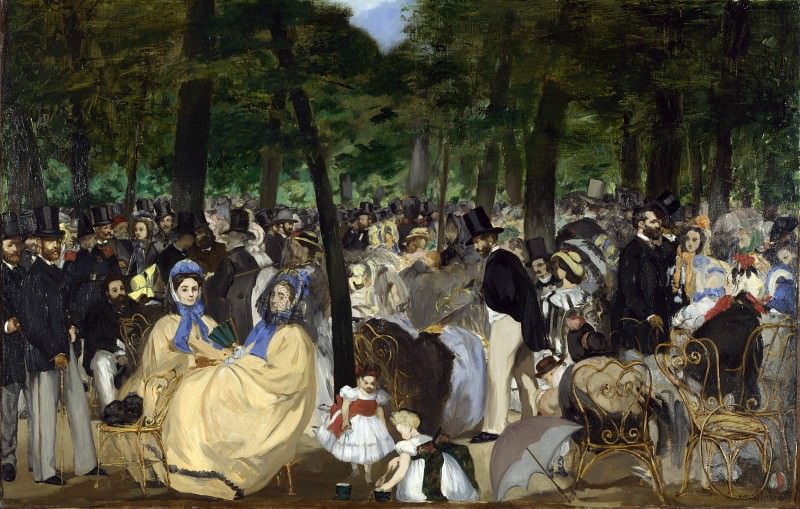Music in the Tuileries Gardens Édouard Manet (1832-1883)
Édouard Manet – Music in the Tuileries Gardens
Edit attribution
Image taken from other album: gallerix.org/s/623387687/N/710934630/
Download full size: 6652×4226 px (12,3 Mb)
Painter: Édouard Manet
Location: National Gallery, London.
The Jardin des Tuileries, a famous park in the center of the French capital, was a favorite place of leisure for Parisians in the 19th century. Its reflections can be found in many literary works, also in paintings and music. The first thing that comes to mind is a short play by Mussorgsky The Tuileries Garden, showing us children playing in the park - the composer vividly depicted it light, spring and crowded.
Description of the painting Music at the Tuileries by Édouard Manet
The Jardin des Tuileries, a famous park in the center of the French capital, was a favorite place of leisure for Parisians in the 19th century. Its reflections can be found in many literary works, also in paintings and music.
The first thing that comes to mind is a short play by Mussorgsky The Tuileries Garden, showing us children playing in the park - the composer vividly depicted it light, spring and crowded. We see it the same way in Manet’s painting, with children running around in the foreground, crowds of holiday-makers and a bright, clear day... Manet’s own family, as well as his friends Charles Baudelaire, Theodore Gautier and Jean Offenbach, are also among the people depicted in the painting.
This canvas is the painter’s first serious work in which he depicted the life of Parisian society. He nurtured the idea of the canvas for a long time, making sketches. But when the canvas was completed, the salon refused him. As often happens, he simply wasn’t understood, not even by his friends. After all, such genre scenes from life at the time were only intended to adorn magazines and articles. To defend the artist’s constant friend the writer Emile Zola, who said that "they will sooner or later realize that Edouard Manet occupies a significant place at this crucial stage of French painting, he will go down in history as the brightest and most independent phenomenon of the era.
Manet completely abandoned here academism, which implied meticulousness in the rendition of details, and where there was no particular difference in how one viewed a canvas - from a close or a far distance, at close viewing of the canvas detail just seemed enlarged. In this painting the artist created such an effect that when you look at the painting closely the faces seem to be some incomprehensible spots of color, but when you look at the painting from a distance, only then you can achieve a portrait likeness.
Кому понравилось
Пожалуйста, подождите
На эту операцию может потребоваться несколько секунд.
Информация появится в новом окне,
если открытие новых окон не запрещено в настройках вашего браузера.
You need to login
Для работы с коллекциями – пожалуйста, войдите в аккаунт (open in new window).




















You cannot comment Why?
Here we see a distinct separation between groups within the crowd. To the left, a cluster of formally dressed individuals – primarily women in elaborate gowns and men in dark suits – are positioned relatively still, observing the scene with an air of detached elegance. A woman seated prominently in this group is rendered with particular attention to detail; her posture suggests contemplation or perhaps mild disapproval of the more animated activities unfolding before her.
In contrast, a lively throng occupies the right side of the painting. Individuals are engaged in dancing and conversation, their gestures and expressions conveying a sense of carefree enjoyment. The artist has employed looser brushstrokes here, contributing to the impression of spontaneous movement and energy. A small child in white with red accents is positioned near this group, adding a touch of youthful exuberance to the scene.
The background features dense foliage and glimpses of sky, establishing the setting as an outdoor space within a structured garden environment. The trees are rendered with broad strokes, suggesting depth and creating a visual frame for the activity below.
Subtly, the painting seems to explore themes of social class and behavior. The contrast between the composed formality of one group and the unrestrained revelry of another hints at differing perspectives on leisure and propriety. The woman in the foreground, with her reserved demeanor, might be interpreted as a symbol of traditional values or perhaps a critique of societal expectations. The overall impression is one of a moment captured – a snapshot of social life within a specific historical context, where distinctions between formality and informality are subtly underscored.